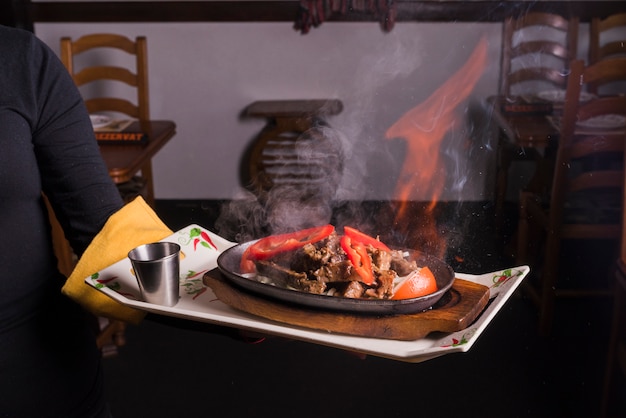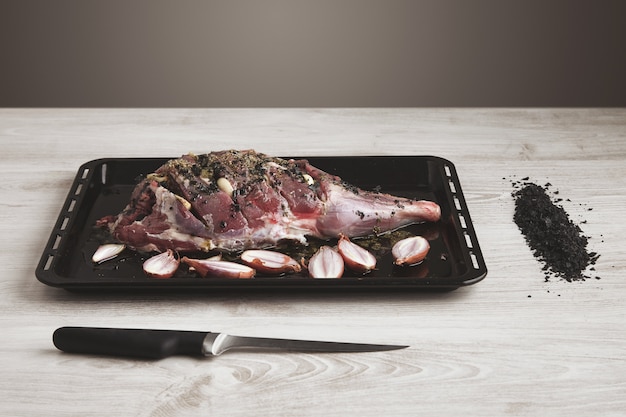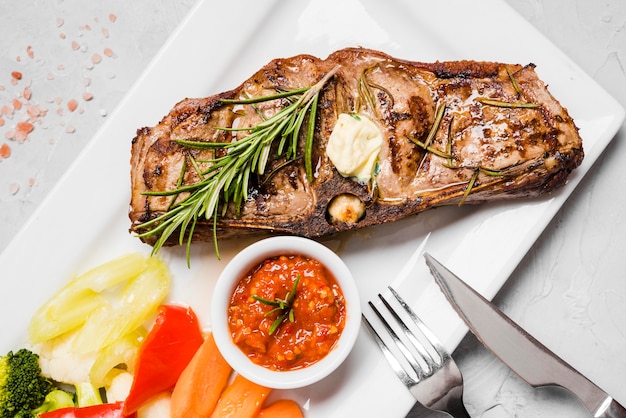Let's talk lamb, shall we? Now, I wouldn't call myself a culinary master, but I've cooked my fair share of lamb over the years and there's nothing quite like a perfectly roasted rack of lamb. It's a showstopper, a real crowd-pleaser, and a dish that makes you feel like a culinary genius. But let's be honest, there's a bit of anxiety that comes with cooking lamb, isn't there? You don't want to overcook it, turning it into a tough, dry mess. On the other hand, you don't want to undercook it, leaving it pink and potentially dangerous. So, how do you nail that perfect medium-rare? Well, that's exactly what we're going to figure out today, step by step. We'll dive into the essentials, walk you through the preparation, and guide you through the cooking process, all while providing helpful tips and tricks along the way. Ready to impress your guests and become a lamb-roasting maestro? Let's get started.
Part 1: The Essentials

Choosing the Right Rack: It's All About the Bones
First things first, you need to choose the right rack of lamb. Now, there are different cuts of lamb, but for this recipe, we're going for a French trimmed rack. Essentially, it's cut into individual chops with the fat layer still intact. It's elegant, and the fat keeps the meat moist during cooking, which is crucial for a tender, juicy result. You can usually find French trimmed racks at your local butcher or supermarket, and they typically come in sizes ranging from 6 to 8 bones. For smaller gatherings, a 6-bone rack is perfect, while for larger groups, an 8-bone rack would be ideal. Don't hesitate to ask your butcher for advice! They can help you choose the right size and quality for your needs.
Temperature Matters: Finding the Sweet Spot
Now, the temperature. We're going with 400 degrees Fahrenheit (200 degrees Celsius) for this recipe. Why? Well, it's the perfect balance for achieving a crispy exterior while keeping the interior juicy and tender. This temperature also helps to create that gorgeous browning on the fat, which adds a ton of flavor. Trust me, that golden-brown crust is not just for looks; it's packed with deliciousness.
Cooking Time: A Quick Guide but No Substitute for Checking
Here's the thing about cooking times: they're not exact sciences. Every oven is different, and the thickness of the rack can vary. So, this is more of a guideline, a starting point for you to work with. For a 6-bone rack of lamb, you'll need around 20-25 minutes at 400 degrees. A 7-bone rack will take around 25-30 minutes, and an 8-bone rack will require around 30-35 minutes. But remember, these are just rough estimates. We'll be checking the internal temperature later, so don't stress too much about the exact time. The key is to cook the lamb until it reaches your desired level of doneness.
Part 2: Prepping Your Rack

Seasoning It Up: Flavoring Your Masterpiece
You've got your rack, you've got your oven set to 400 degrees, now it's time to get serious about seasoning. This is where you can really make the dish your own. I like to keep it simple, but there are endless possibilities.
- Salt and Pepper: This is a classic for a reason. Salt and pepper enhance the natural flavors of the lamb, creating a base that's perfect for additional seasonings. A good pinch of each will bring out the lamb's inherent goodness.
- Garlic Powder: Garlic is always a good call, and garlic powder is an easy way to add a subtle, garlicky flavor. It's a great way to enhance the richness of the lamb without being overpowering.
- Rosemary: If you're going for a more herbaceous flavor, rosemary is a fantastic option. The combination of rosemary and lamb is just divine. The earthy aroma of rosemary complements the lamb beautifully, creating a truly classic flavor pairing.
- Herbs de Provence: A blend of herbs that includes rosemary, thyme, and lavender, this mix adds a complex, aromatic flavor to the lamb. It adds a touch of sophistication and creates a beautifully balanced flavor profile.
- Paprika: For a bit of heat and color, try a touch of paprika. It adds a subtle smokiness that complements the lamb beautifully. A hint of paprika can add a nice depth of flavor without being too spicy.
Don't be afraid to experiment with different combinations of herbs and spices. You can even try rubbing the lamb with a flavored olive oil for an extra layer of flavor.
The Importance of Resting: Letting the Lamb Breathe
Before you pop that rack into the oven, let it rest at room temperature for about 30 minutes. This allows the meat to come to room temperature, which helps it cook more evenly. You'll also get a more tender result. Imagine it like letting the lamb breathe before it goes into the oven. It allows the meat to relax and distribute its juices evenly, resulting in a more succulent experience.
Part 3: Into the Oven It Goes

Alright, your oven is preheated, your rack is seasoned, and it's time to get cooking! I find it easiest to use a roasting pan. Place the rack of lamb in the pan, fat side up. This ensures that the fat renders evenly and adds moisture and flavor to the meat. You'll want to cook the lamb for around 20-30 minutes, depending on the size of the rack.
The Internal Temperature: A Crucial Check
Now, here's where it gets a bit serious. You need to check the internal temperature of the lamb to make sure it's cooked to your liking. I personally prefer a medium-rare rack of lamb, which has an internal temperature of 135 degrees Fahrenheit (57 degrees Celsius).
Use a meat thermometer to check the internal temperature of the thickest part of the lamb. If you're aiming for medium-rare, you want the temperature to be around 135 degrees. If you prefer your lamb cooked a bit more, you can aim for 140 degrees (60 degrees Celsius) for medium.
Here's a helpful table to give you a visual guide:
| Doneness | Internal Temperature (Fahrenheit) | Internal Temperature (Celsius) |
|---|---|---|
| Rare | 125-130 | 52-54 |
| Medium-Rare | 130-135 | 54-57 |
| Medium | 135-140 | 57-60 |
| Medium-Well | 140-145 | 60-63 |
| Well-Done | 145+ | 63+ |
Don't worry, it's not as intimidating as it sounds. A meat thermometer is your best friend in this situation. It takes the guesswork out of cooking and ensures that your lamb is perfectly cooked. It's a small investment that pays off big time.
Part 4: Resting, Slicing, and Serving
Let It Rest: A Moment of Patience
Once the lamb is cooked to your liking, remove it from the oven and let it rest for 10-15 minutes. This allows the juices to redistribute throughout the meat, resulting in a more tender and flavorful lamb. I know it's hard to wait, but trust me, it's worth it. This little bit of patience will make a big difference in the final result.
Slicing It Up: A Touch of Elegance
After resting, you can slice the lamb into individual chops. You can use a sharp knife or a meat cleaver for this task. If you're feeling fancy, you can use a meat cleaver, but a sharp chef's knife will do the job just fine. Place the sliced lamb on a platter and arrange it attractively. If you're serving it at a dinner party, this is your chance to showcase your culinary skills.
Part 5: The Finishing Touches
Gravy: The Secret Sauce
Now, this is where you can really elevate your rack of lamb game. A delicious, homemade gravy adds another layer of flavor and richness to the dish. It's the perfect finishing touch.
Here's how I make my gravy:
- Deglaze the Pan: After removing the lamb, you'll have delicious drippings left in the roasting pan. Add a splash of red wine or broth to the pan and scrape up the browned bits from the bottom. This is called deglazing, and it's how you extract all that delicious flavor. The browned bits, known as fond, are packed with flavor. You're essentially creating a flavorful base for your gravy.
- Whisk and Simmer: Whisk in a tablespoon or two of flour to thicken the sauce. Bring the mixture to a simmer and cook until it thickens. This is how you create the velvety texture of a good gravy.
- Season and Strain: Season the gravy with salt and pepper to taste. You can also add a pinch of herbs or spices, like rosemary, thyme, or garlic powder, to enhance the flavor. Finally, strain the gravy to remove any lumps. This ensures a smooth and elegant gravy.
If you're feeling ambitious, you can even add a dollop of butter to the gravy for an extra layer of richness. Don't be afraid to experiment and find your own favorite gravy recipe. It's a great way to personalize your rack of lamb.
The side dishes: Making a Statement
You've got your delicious rack of lamb, and now it's time to think about side dishes. I always try to create a balance of flavors and textures.
- Roasted Vegetables: Roasted vegetables like carrots, potatoes, or asparagus are a classic pairing with lamb. They add a sweet and earthy flavor that complements the lamb perfectly. The roasting process brings out the natural sweetness of the vegetables and creates a wonderful contrast in textures with the lamb.
- Green Salad: A fresh and crisp green salad balances the richness of the lamb. Choose a variety of greens, vegetables, and a light vinaigrette dressing. A green salad adds a touch of freshness and lightness to the meal.
- Creamy Polenta: Creamy polenta adds a comforting touch to the meal. It also provides a contrast in texture to the lamb and vegetables. The creamy texture of polenta is a delightful counterpoint to the firm texture of the lamb.
Of course, you can also choose other side dishes that you enjoy. The important thing is to create a balanced and flavorful meal. Don't be afraid to get creative and experiment with different side dishes.
Part 6: A Little Inspiration
My Go-To Recipe: A Simple, Classic Choice
I've cooked a lot of lamb in my time, and this recipe is my personal favorite. It's simple, flavorful, and always impresses.
- Seasoning: I like to keep it simple with salt, pepper, garlic powder, and rosemary. These classic flavors enhance the natural taste of the lamb and create a delicious, aromatic crust.
- Roasting: I cook the rack of lamb for 25-30 minutes at 400 degrees Fahrenheit, depending on the size. The key is to cook the lamb until it reaches your desired internal temperature, which is usually around 135 degrees for medium-rare.
- Gravy: I deglaze the pan with red wine, whisk in a tablespoon of flour, and simmer until thickened. The red wine adds a touch of complexity and depth to the gravy.
- Side Dishes: I typically serve my lamb with roasted carrots and potatoes, and a light green salad. This combination of flavors and textures is classic and always satisfying.
It's a recipe that's easy to follow, but always produces a delicious result. And the best part is that it's incredibly versatile. You can easily adapt it to your own preferences by adding different herbs and spices, or changing the side dishes.
Beyond the Basics: Exploring flavor combinations
While I love the classic flavors of salt, pepper, and rosemary, there's a world of possibilities when it comes to seasoning lamb. Don't be afraid to experiment and find your own favorite combinations.
Here are a few ideas to get you started:
- Mediterranean Flavors: Combine lemon zest, garlic, oregano, and thyme for a bright and flavorful lamb. These flavors are reminiscent of the Mediterranean coast and add a refreshing touch to the lamb.
- Asian Inspiration: Use ginger, soy sauce, honey, and sesame oil for a savory and sweet glaze. This combination of flavors brings a taste of Asia to your lamb, creating a unique and delicious experience.
- Spice It Up: Add a touch of cumin, coriander, or paprika to give your lamb a spicy kick. These spices add a warmth and depth to the lamb, creating a more complex flavor profile.
Remember, the beauty of cooking is in the exploration. Don't be afraid to experiment and find what you enjoy. You might just discover a new favorite flavor combination.
Part 7: FAQs
1. What If My Rack of Lamb Is Too Big?
If your rack of lamb is too big for your roasting pan, you can always cut it in half and roast it in two separate pans. Just make sure to adjust the cooking time accordingly. It's best to cook each half separately to ensure even cooking.
2. How Do I Know If My Lamb Is Done?
The best way to determine if your lamb is cooked to your liking is to use a meat thermometer. Aim for an internal temperature of 135 degrees Fahrenheit for medium-rare, or 140 degrees Fahrenheit for medium. A meat thermometer is the most reliable way to ensure that your lamb is cooked to your desired level of doneness.
3. Can I Cook Rack of Lamb on the Grill?
Absolutely! Grilling rack of lamb is a great way to add a smoky flavor. Just make sure to preheat your grill to medium-high heat and cook the lamb for about 10-12 minutes per side, or until it reaches your desired internal temperature. Grilling adds a wonderful smoky flavor to the lamb and creates a delicious char.
4. What Kind of Wine Should I Serve with Rack of Lamb?
A bold red wine like Cabernet Sauvignon, Merlot, or Shiraz pairs well with the richness of lamb. These wines have rich tannins and fruit flavors that complement the lamb beautifully.
5. Can I Freeze Rack of Lamb?
Yes, you can freeze rack of lamb for up to 3 months. Make sure to wrap it tightly in plastic wrap and aluminum foil to prevent freezer burn. When you're ready to use it, thaw it in the refrigerator for 1-2 days. Freezing lamb is a great way to stock up on this delicious protein. Just make sure to thaw it properly before cooking.
Part 8: Conclusion
Alright, there you have it, a comprehensive guide to cooking rack of lamb at 400 degrees. Remember, it's not about perfection, it's about having fun in the kitchen and creating a delicious meal that you and your loved ones will enjoy. So, go forth, experiment, and let your inner chef shine!
With a bit of practice, you'll be a lamb-roasting master in no time. And who knows, you might even discover a new favorite flavor combination. Happy cooking!
Everyone is watching

How to Cook Frozen Lobster Tails Perfectly: A Step-by-Step Guide
RecipesLobster. Just the word conjures up images of lavish meals, special occasions, and a taste of luxury. But let's...

Pigs in a Blanket Cooking Time: How Long to Bake for Perfect Results
RecipesAh, pigs in a blanket. Just the name conjures up images of those delightful little parcels of crispy pastry en...

Pork Fillet Cooking Time: How Long to Cook It Perfectly
RecipesPork fillet, or tenderloin as it's sometimes called, is a real favourite in our house. It's so versatile, and...

The Ultimate Guide to Tender, Juicy Pulled Pork
RecipesRight, let's talk pulled pork. It's one of those dishes that just screams "comfort food," doesn't it? I mean...

The Ultimate Guide to Cooking Sweet Potatoes: From Roasting to Mashing
RecipesSweet potatoes. Just the name conjures up images of warm, comforting dishes, bursts of vibrant color, and a to...
